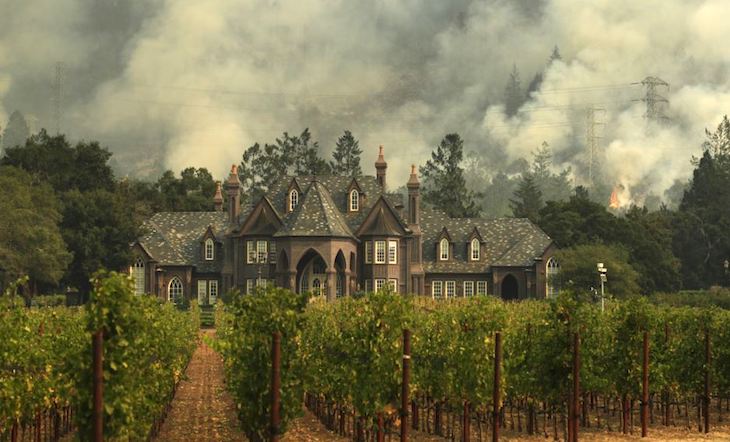
I watched with horror in October as wild fires devastated the beautiful Napa Valley landscape. I barely escaped the fires since I was in Napa filming for a wine documentary with the TV Chosun filming team just several weeks before the fires started. After weeks of red flames engulfing the valley, the result was 41 people dead and 89,000 hectares of land shriveled to dust.
In a stroke of luck, the prime vineyards of Napa Valley were left unscathed. For example, the fires did not touch top vineyards in Rutherford or Oakville. Also 95% of the grapes in vineyards in Napa and Sonoma were already harvested and the grape juice inside the tank by the time the fires erupted. Out of 330 members of the Napa Valley Vintners Association, 47 reported direct damage and around 16 wineries, such as Signorello, White Roch and Roy Estate, reported that their wineries were destroyed by the fire.
The wine industry in California contributes US$58 billion to the state according to Bloomberg (reported on 12 Oct 2017) and in Napa 40% of the employees work for wine-related businesses. So what is the impact for consumers and lovers of Napa Valley wines? The quantity of 2017 will definitely go down since around 5-10% of the crop was still left hanging on the vines when the fires started. Whether the final prices of 2017 wines will go up or down will depend on the wineries decisions given their smaller quantity. I would expect the prices for the 2017 vintage may rise a bit more than usual given the smaller volumes.
When I was in Napa at the end of August and early September this year, it was one of the hottest periods on record, not just during the day but even at night – the temperatures stayed high at over 35 degrees Celcius on some nights. Given the very dry conditions and hot weather, it was a terrible tragedy to have the fires break out and spread so quickly under such circumstances.
I remember my first visit to Napa Valley in 1990. The beauty of the Mayacamas mountain ranges with manicured vineyards being cooled by the Pacific Ocean breeze took my breath away. Part of wine industry’s allure for me has always been about more than the seductive wines, but also the lifestyle, the people and the gorgeous wine growing region.
There are so many scenic wine regions in the world: The rugged Cape Town landscape with the dramatic horizons in South Africa ranks among the most beautiful; the undulating valleys of Tuscany with its quaint villages are picturesque; the charming towns at the foot of the steep slopes of the Mosel Valley are gorgeous. But Napa is special because it combines visually stunning landscapes with people who are extremely friendly, passionate about wine and have built up a great wine tourism industry.
Tastings rooms are large and inviting and one is often greeted by a bubbly Californian tasting room attendant who smiles as though you have just made their day by walking in through the tasting room door. As you depart, you will often hear: “Great to have you visit us! I hope you enjoy your visit to Napa Valley!” Napa ranks as one of the most sophisticated and friendly wine tourism destinations in the world. Spend a day visiting any wine region in France or Italy and you will know what I mean.
In the past few decades while the French have spent huge air miles promoting their wines in China and in Hong Kong, the Americans were homebound busy catering to their own growing domestic demand for fine wines. Recently, over the past 10 years, Californian wineries have made much more of an effort to promote their wines in the Asian and Chinese markets.
Bill Harlan is one of the pioneers in Napa Valley for establishing a pioneering high quality, uniquely Napa wine, Harlan, that has a strong following and recognition in Asia. He says, “We have been incredibly fortunate. Our team is safe, and our winemaking and hospitality facilities escaped unscathed. The majority of this year’s fruit was safely harvested before the wildfires began, and amidst the displacement and upheaval, the 2017 vintage will be one we will never forget. Together we will rebuild the parts of our valley that suffered damage from this tragic occurrence.”
Top wineries like Harlan will no doubt recover quickly from this disaster. Many are establishing funds for those who have been less fortunate. For many family owned wineries, which make up the vast majority of Napa wineries, many with production of less than 2,000 cases per year, any help from the fire damage will be welcome. I hope and pray that the recovery of this scenic region will happen quickly.









